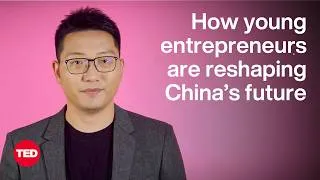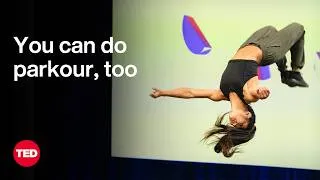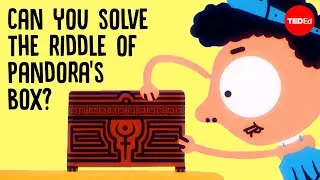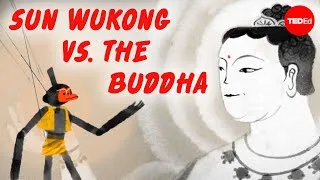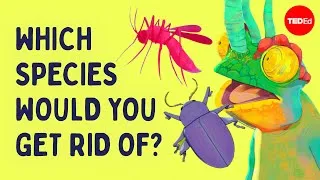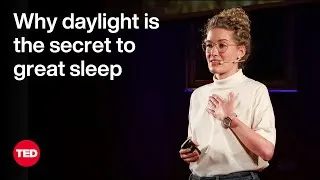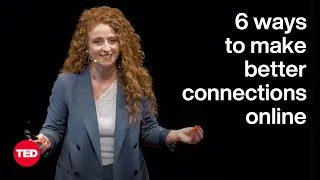請雙擊下方英文字幕播放視頻。
譯者: Pauline YW Lin
審譯者: Adrienne Lin
00:12
Last year at TED we aimed to try to clarify
0
12160
4000
去年在TED 我們主要試著去釐清
00:16
the overwhelming complexity
1
16160
2000
在研討會中我們所獲得的
00:18
and richness that we experience at the conference
2
18160
3000
那麼龐雜,豐富的資訊
00:21
in a project called Big Viz.
3
21160
2000
這個計畫就叫做Big Viz
00:23
And the Big Viz is a collection of 650 sketches
4
23160
3000
而Big Viz 收集了650件草圖
00:26
that were made by two visual artists.
5
26160
2000
這些全是由二位藝術家所完成
00:28
David Sibbet from The Grove,
6
28160
2000
The Grove的大衛西貝特
00:30
and Kevin Richards, from Autodesk,
7
30160
2000
以及Autodesk的凱文理查
00:32
made 650 sketches that strive to capture
8
32160
3000
所完成的650件草圖,設法掌握到
00:35
the essence of each presenter's ideas.
9
35160
4000
每位演講者想法的本質
00:39
And the consensus was: it really worked.
10
39160
2000
而大家一致認為,真的成功了
00:41
These sketches brought to life the key ideas,
11
41160
4000
這些草圖生動地呈現出關鍵的想法
00:45
the portraits, the magic moments
12
45160
2000
我們去年所接觸到的人物
00:47
that we all experienced last year.
13
47160
2000
以及我們所渡過的動人的時刻
00:49
This year we were thinking, "Why does it work?"
14
49160
3000
今年我們則在思考: 這為什麼會成功?
00:52
What is it about animation,
15
52160
2000
究竟是動畫
00:54
graphics, illustrations, that create meaning?
16
54160
3000
圖像?還是插畫?創造了意義?
00:57
And this is an important question to ask and answer
17
57160
3000
這會是一個重要的問題要回答的
01:00
because the more we understand how the brain creates meaning,
18
60160
3000
因為我們愈了解大腦是如何創造意義的
01:03
the better we can communicate,
19
63160
2000
我們就愈能有效溝通
01:05
and, I also think, the better we can think and collaborate together.
20
65160
3000
而我也認為, 也就愈能思考與合作得更好
01:08
So this year we're going to visualize how
21
68160
2000
因此今年我們要看看
01:10
the brain visualizes.
22
70160
2000
大腦如何呈現視覺
01:12
Cognitive psychologists now tell us that the brain
23
72160
2000
認知心理學家告訴我們
01:14
doesn't actually see the world as it is,
24
74160
3000
大腦並不是真的看見這個世界的樣子
01:17
but instead, creates a series of mental models
25
77160
3000
而是創造一連串的心智模式
01:20
through a collection of "Ah-ha moments,"
26
80160
2000
透過許多頓悟、發現的瞬間所組成
01:22
or moments of discovery, through various processes.
27
82160
2000
或透過各式各樣的過程
01:24
The processing, of course, begins with the eyes.
28
84160
3000
這些過程,當然是從眼睛開始的
01:27
Light enters, hits the back of the retina, and is circulated,
29
87160
3000
光線進到視網膜後面,然後被傳遞
01:30
most of which is streamed to the very back of the brain,
30
90160
3000
大部分會進到大腦的最後面
01:33
at the primary visual cortex.
31
93160
2000
進到主要視覺皮質區
01:35
And primary visual cortex sees just simple geometry,
32
95160
3000
而主要視覺皮質只會看見簡單的幾何圖形
01:38
just the simplest of shapes.
33
98160
2000
屬於最簡單的形狀
01:40
But it also acts like a kind of relay station
34
100160
3000
但它也像是個轉運站在運作
01:43
that re-radiates and redirects information
35
103160
2000
重新發射和重新定向訊號
01:45
to many other parts of the brain.
36
105160
3000
到大腦的其他部分
01:48
As many as 30 other parts that selectively make more sense,
37
108160
3000
大腦的其他三十幾個部分則選擇性地產生更多知覺
01:51
create more meaning through the kind of "Ah-ha" experiences.
38
111160
3000
透過頓悟的經驗創造出意義
01:54
We're only going to talk about three of them.
39
114160
2000
我們現在只要談其中的三個
01:56
So the first one is called the ventral stream.
40
116160
3000
首先是腹側流
01:59
It's on this side of the brain.
41
119160
2000
它位在大腦的側邊
02:01
And this is the part of the brain that will recognize what something is.
42
121160
4000
是大腦辨識東西的部位
02:05
It's the "what" detector.
43
125160
2000
它是一個"這是什麼"偵測器
02:07
Look at a hand. Look at a remote control. Chair. Book.
44
127160
4000
看一下手,看一看遙控器、椅子、書
02:11
So that's the part of the brain that is activated
45
131160
3000
所以這是大腦活躍的部分
02:14
when you give a word to something.
46
134160
2000
能說出物體的正確名稱
02:16
A second part of the brain is called the dorsal stream.
47
136160
3000
大腦的第二個部份叫做背側流
02:19
And what it does is locates the object
48
139160
3000
而它主要幫物體定位
02:22
in physical body space.
49
142160
3000
在實體空間中
02:25
So if you look around the stage here
50
145160
2000
所以當你看看舞台四周
02:27
you'll create a kind of mental map of the stage.
51
147160
3000
你就會創造一個舞台的心智地圖
02:30
And if you closed your eyes you'd be able to mentally navigate it.
52
150160
3000
如果閉上眼睛,你也能夠用心智走動
02:33
You'd be activating the dorsal stream if you did that.
53
153160
3000
這是你正在活用你的背側流
02:36
The third part that I'd like to talk about
54
156160
2000
第三個我想要講的部分
02:38
is the limbic system.
55
158160
2000
是邊緣系統
02:40
And this is deep inside of the brain. It's very old, evolutionarily.
56
160160
3000
位於大腦的深層部位,在進化上它是非常古老的
02:43
And it's the part that feels.
57
163160
2000
屬於感覺的部分
02:45
It's the kind of gut center, where you see an image
58
165160
2000
它算是一種直覺中心,你看見了影像
02:47
and you go, "Oh! I have a strong
59
167160
2000
會覺得: 喔! 對於這個東西
02:49
or emotional reaction to whatever I'm seeing."
60
169160
4000
我有種強烈、情緒性的感受
02:53
So the combination of these processing centers
61
173160
3000
所以結合這些程序中心
02:56
help us make meaning in very different ways.
62
176160
4000
幫助我們用不同方式產生意義
03:00
So what can we learn about this? How can we apply this insight?
63
180160
3000
所以我們從這學到什麼? 可以怎麼用這些洞察?
03:03
Well, again, the schematic view
64
183160
2000
再一次的,用草圖表示
03:05
is that the eye visually interrogates what we look at.
65
185160
3000
眼睛會問我們在看什麼
03:08
The brain processes this in parallel, the figments of information
66
188160
3000
大腦則同步處理這些虛構的訊息
03:11
asking a whole bunch of questions
67
191160
2000
藉由提出一連串的問題
03:13
to create a unified mental model.
68
193160
2000
創造出統一的心智模式
03:15
So, for example, when you look at this image
69
195160
3000
舉個例子,當你看著這個影像
03:18
a good graphic invites the eye to dart around,
70
198160
3000
一個好圖會讓你的眼睛停留在四周
03:21
to selectively create a visual logic.
71
201160
2000
而選擇性地創造了視覺邏輯
03:23
So the act of engaging, and looking at the image creates the meaning.
72
203160
5000
所以透過行動及影像觀看創造了意義
03:28
It's the selective logic.
73
208160
2000
這是選擇性邏輯
03:30
Now we've augmented this and spatialized this information.
74
210160
3000
現在我們已經詳細說明這個資訊
03:33
Many of you may remember the magic wall that we built
75
213160
3000
你們很多人應該還記得我們所建造的神奇之牆
03:36
in conjunction with Perceptive Pixel
76
216160
2000
連結了感知像素
03:38
where we quite literally create an infinite wall.
77
218160
3000
這我們確實是創造了一個無限之牆
03:41
And so we can compare and contrast the big ideas.
78
221160
2000
因此我們可以比較並對照這個大想法
03:43
So the act of engaging and creating interactive imagery
79
223160
3000
透過參與行動與建立交互影像
03:46
enriches meaning.
80
226160
2000
能夠豐富意義
03:48
It activates a different part of the brain.
81
228160
3000
它讓大腦的不同部位活躍起來
03:51
And then the limbic system
82
231160
2000
邊緣系統的活躍
03:53
is activated when we see motion, when we see color,
83
233160
3000
在我們看見動作、看見顏色的時候
03:56
and there are primary shapes and pattern detectors
84
236160
3000
那裡有主要形狀及圖樣的偵測器
03:59
that we've heard about before.
85
239160
2000
這我們其實已經知道的
04:01
So the point of this is what?
86
241160
2000
所以到底重點是什麼?
04:03
We make meaning by seeing,
87
243160
3000
我們透過視覺診斷
04:06
by an act of visual interrogation.
88
246160
2000
來製造意義
04:08
The lessons for us are three-fold.
89
248160
2000
這堂課對我們有三個面向
04:10
First, use images to clarify what we're trying to communicate.
90
250160
4000
首先,用影像來釐清我們設法要傳達的東西
04:14
Secondly make those images interactive
91
254160
3000
第二,讓這些影像有互動
04:17
so that we engage much more fully.
92
257160
2000
因此我們能夠更投入
04:19
And the third is to augment memory
93
259160
2000
第三,藉由讓視覺持續
04:21
by creating a visual persistence.
94
261160
2000
來強化記憶
04:23
These are techniques that can be used to be --
95
263160
3000
這些技術可以用來
04:26
that can be applied in a wide range of problem solving.
96
266160
4000
應用在廣泛的問題解決
04:30
So the low-tech version looks like this.
97
270160
2000
而低階的版本看起來就像這樣
04:32
And, by the way, this is the way in which
98
272160
2000
另外,這就是我們Autodesk
04:34
we develop and formulate
99
274160
2000
用來發展與規劃
04:36
strategy within Autodesk,
100
276160
2000
的策略
04:38
in some of our organizations and some of our divisions.
101
278160
3000
在我們的一些組織和部門
04:41
What we literally do is have the teams
102
281160
2000
我們真正做的只是讓團隊
04:43
draw out the entire strategic plan
103
283160
3000
在一個巨大的牆上
04:46
on one giant wall.
104
286160
2000
畫出整個策略計畫
04:48
And it's very powerful because everyone gets to see everything else.
105
288160
4000
這相當的強而有力,因為每個人都能看到別人的
04:52
There's always a room, always a place
106
292160
2000
那兒總是會有空間、總有位子
04:54
to be able to make sense of all of the components
107
294160
3000
能夠讓所有的組件在這個策略計畫中
04:57
in the strategic plan.
108
297160
2000
都產生意義
04:59
This is a time-lapse view of it.
109
299160
3000
這是一個時間快轉的景像
05:02
You can ask the question, "Who's the boss?"
110
302160
2000
你可以提出這樣的問題: 到底誰是老闆?
05:04
You'll be able to figure that out. (Laughter)
111
304160
8000
而你將可以看得出來
05:12
So the act of collectively and collaboratively
112
312160
3000
所以共同合作的行動
05:15
building the image
113
315160
2000
建立起影像
05:17
transforms the collaboration.
114
317160
3000
進而形成協同運作
05:20
No Powerpoint is used in two days.
115
320160
2000
這二天,沒有使用簡報軟體
05:22
But instead the entire team
116
322160
2000
取而代之的是,整個團隊
05:24
creates a shared mental model
117
324160
2000
創造了共享的心智模式
05:26
that they can all agree on and move forward on.
118
326160
3000
他們所有人都能認同及前進
05:29
And this can be enhanced and augmented with
119
329160
2000
這能夠強化、擴大
05:31
some emerging digital technology.
120
331160
3000
一些發展中的數位科技
05:34
And this is our great unveiling for today.
121
334160
3000
這就是今天的揭示
05:37
And this is an emerging set of technologies
122
337160
2000
這是一個新興的科技組合
05:39
that use large-screen displays
123
339160
3000
使用大型螢幕展示
05:42
with intelligent calculation in the background
124
342160
3000
並有智慧型電腦在背後
05:45
to make the invisible visible.
125
345160
2000
讓看不見的東西視覺化
05:47
Here what we can do is look at sustainability, quite literally.
126
347160
3000
這裡我們能做的是持續看著
05:50
So a team can actually look at
127
350160
3000
一個團隊能夠真正看到
05:53
all the key components that heat the structure
128
353160
3000
所有的組成結構的關鍵
05:56
and make choices and then see the end result
129
356160
2000
並做出決定,在這個螢幕上
05:58
that is visualized on this screen.
130
358160
3000
看見最後成果
06:01
So making images meaningful has three components.
131
361160
3000
讓影像產生意義有三個部分
06:04
The first again, is making ideas clear by visualizing them.
132
364160
3000
第一,藉由視覺化讓想法清楚呈現
06:07
Secondly, making them interactive.
133
367160
2000
第二,讓它們互動
06:09
And then thirdly, making them persistent.
134
369160
2000
第三,讓他們持續
06:11
And I believe that these three principles
135
371160
2000
我相信這三個原則
06:13
can be applied to solving some of the very tough problems
136
373160
4000
能夠應用在解決我們所面對的
06:17
that we face in the world today. Thanks so much.
137
377160
2000
艱難問題上。謝謝大家
06:19
(Applause)
138
379160
2000
(掌聲)
New videos
關於本網站
本網站將向您介紹對學習英語有用的 YouTube 視頻。 您將看到來自世界各地的一流教師教授的英語課程。 雙擊每個視頻頁面上顯示的英文字幕,從那裡播放視頻。 字幕與視頻播放同步滾動。 如果您有任何意見或要求,請使用此聯繫表與我們聯繫。
